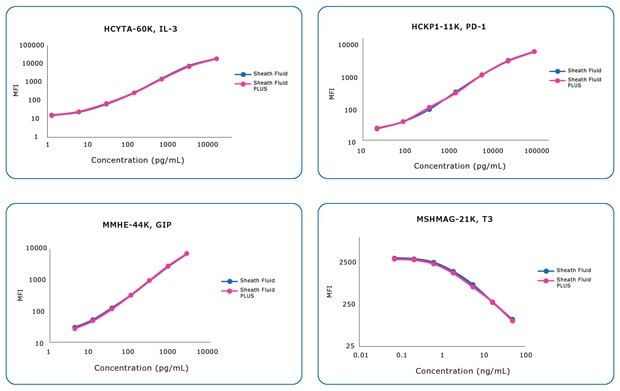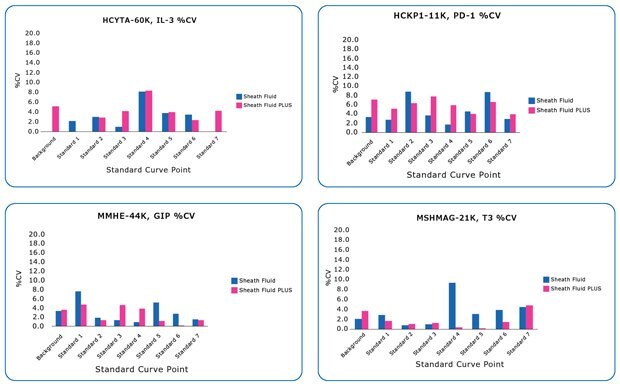Comparing xMAP® Sheath Fluid PLUS to Sheath Fluid Using MILLIPLEX® Multiplex Kits
Luminex® Corporation has developed new xMAP® Sheath Fluid PLUS and Drive Fluid PLUS products. The new formulation contains three modes of microbial action, including sodium azide, sodium benzoate, and diazolidinyl urea, which replaces the single-mode ProClin™ formulation. The updated formulation in the PLUS products allows for greater stability and reduces variations in preservative potency and discoloration related to ProClin™ degradation. Moreover, the enhanced cocktail protects instrument fluidic pathways and eliminates potential environmental microbial resistance to ProClin™ preservatives. Read on to see a performance comparison of the previous xMAP® Sheath Fluid to the new xMAP® Sheath Fluid PLUS formulation in MILLIPLEX® multiplex assays.
New xMAP® Sheath Fluid PLUS Formulation
The previous Sheath Fluid formulation contained one bacteriostatic preservative, ProClin™ preservative. ProClin™ preservative is susceptible to microbial resistance and degradation following prolonged heat exposure. The new xMAP® Sheath Fluid PLUS and Drive Fluid PLUS formulations contain three preservatives, offering bacteriostatic, fungistatic, and bactericidal elements with sodium azide, sodium benzoate, and diazolidinyl urea. This combination is more effective than ProClin™ preservative alone and is well-suited for prolonged exposure to ambient temperature during transport. The core formulation of the Sheath Fluid remains the same, a diluted phosphate-buffered saline (PBS) solution composed of 99% water and 1% of sodium/potassium salts, phosphate salts, sodium azide, sodium benzoate, and diazolidinyl urea. Table 1 outlines the previous Sheath Fluid catalog numbers and the comparable new Sheath and Drive Fluid PLUS catalog numbers and descriptions.
Sheath Fluid vs. Sheath Fluid PLUS
Both Sheath Fluid formulations act as a medium for transporting the magnetic beads from the well to the detection channel. The experiments performed were intended to demonstrate that the PLUS formulation is compatible with a range of assay chemistries and does not cause adverse effects related to assay performance. This study demonstrates that the MILLIPLEX® multiplex assays generated expected results regardless of the type of Sheath Fluid used.
Materials and Methods
For the scope of this study, Standards and Quality Controls (QCs) from four MILLIPLEX® multiplex panels were evaluated with both Sheath Fluid and Sheath Fluid PLUS formulations.
Standard curves from each of the four MILLIPLEX® multiplex panels were run in duplicates and QCs were analyzed in quadruplets on a single 96-well plate, prepared according to the kit protocol. One 96-well plate was prepared for use with Sheath Fluid and one with Sheath Fluid PLUS. The plates were run on the Luminex® 200™ system. The data was analyzed using Belysa® Immunoassay Curve Fitting Software (Cat. No. 40-122).
Comparison Results
Standard curves were plotted for each analyte across all included MILLIPLEX® panels. Coefficients of variation (%CV) were calculated for each standard curve point to compare xMAP® Sheath Fluid PLUS performance. The MILLIPLEX® standard curves demonstrated comparable median fluorescence intensities (MFI) and no change in performance when using Sheath Fluid PLUS compared to Sheath Fluid (Figure 1).

Figure 1.Representative standard curves for four MILLIPLEX® panels using Sheath Fluid (blue) and Sheath Fluid PLUS (magenta).
The %CVs at each standard point and background, analyzed in duplicate, were <10% (Figure 2).

Figure 2.Representative %CV for standard replicates from four MILLIPLEX® kits using Sheath Fluid (blue) and Sheath Fluid PLUS (magenta).
Furthermore, QC data was also evaluated in quadruplicate to compare Sheath Fluid PLUS against Sheath Fluid (Table 2). QC values demonstrated little variation and fell within the assigned QC ranges. For the scope of this article, data for only one analyte across each panel is shown. This data is representative of all the analytes in each of the respective panels.
Summary
No major change or deviation was observed in the data using four MILLIPLEX® panels, containing 76 analytes in total, when using xMAP® Sheath Fluid or Sheath Fluid PLUS. This study demonstrates that Sheath Fluid PLUS retains the same performance as Sheath Fluid and that it does not affect the performance of MILLIPLEX® assays. Moreover, Sheath Fluid PLUS provides stronger anti-microbial activity and better transit stability compared to the Sheath Fluid.
Materials
For Research Use Only. Not For Use In Diagnostic Procedures.
To continue reading please sign in or create an account.
Don't Have An Account?